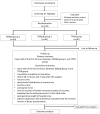Transmuscular quadratus lumborum block versus thoracic paravertebral block for acute pain and quality of recovery after laparoscopic renal surgery: study protocol for a randomized controlled trial
- PMID: 31109368
- PMCID: PMC6528343
- DOI: 10.1186/s13063-019-3359-7
Transmuscular quadratus lumborum block versus thoracic paravertebral block for acute pain and quality of recovery after laparoscopic renal surgery: study protocol for a randomized controlled trial
Abstract
Background: Quadratus lumborum block (QLB) is increasingly gaining popularity as a novel abdominal truncal block in abdominal surgery; however, the mechanism of QLB is not yet thoroughly illustrated. The focus of our study is transmuscular QLB (TMQLB), as the latest anatomical evidence shows that anesthetics spread into the thoracic paravertebral space to exert an analgesic effect. Therefore, we designed this study to compare TMQLB with thoracic paravertebral block (TPVB) in laparoscopic renal surgery in the hope of providing clinical evidence on the analgesic mechanism of TMQLB and its application in laparoscopic renal surgery.
Methods: This trial is a prospective, randomized, single-center, open-label, parallel, three-arm, non-inferiority trial. We intend to include 120 participants undergoing laparoscopic nephrectomy and before surgery they will be randomized into three groups for postoperative pain control: TMQLB experimental group 1 (0.4 ml/kg body weight 0.5% ropivacaine), TMQLB experimental group 2 (0.6 ml/kg body weight 0.5% ropivacaine) or TPVB control group (0.4 ml/kg body weight 0.5% ropivacaine at vertebra T10). Patients will be excluded if they have allergy to anesthetics, infection at the injection site, are on coagulopathy or anticoagulants, on analgesics for chronic illness, have history of substance abuse or have a barrier to communication. Morphine is given in boluses of 1.5~2 mg by intravenous patient-controlled analgesia (IPCA) in the first 48 h after surgery. The primary outcome is the difference between TMQLB group 1 and the TPVB group in the mean visual analogue scale (VAS) pain score in the first 24 h after surgery. Secondary outcomes are the difference between TMQLB group 2 and the TPVB group in the mean VAS score in the first 24 h after surgery, cumulative morphine consumption, long-term pain control, dermatomal distribution of sensory loss, nausea score, pruritus score, ambulation time, time till recovery of bowel movement, quality of recovery, postoperative length of hospital stay and patient satisfaction with anesthesia. Safety data on procedure-related complications will also be summarized.
Discussion: This will the first randomized controlled trial to compare TMQLB with TPVB for analgesia in laparoscopic surgery. This trial aims to provide important clinical evidence to elaborate on the analgesic mechanism of TMQLB.
Trial registration: ClinicalTrials.gov, NCT03414281 . Registered on 9 January 2018.
Keywords: Laparoscopic surgery; Quadratus lumborum block; Thoracic paravertebral block.
Conflict of interest statement
The authors declare that they have no competing interests.
Figures
Similar articles
-
Transmuscular quadratus lumborum (TQL) block for laparoscopic colorectal surgery: study protocol for a double-blind, prospective randomized placebo-controlled trial.Trials. 2020 Jun 26;21(1):581. doi: 10.1186/s13063-020-04525-6. Trials. 2020. PMID: 32586361 Free PMC article.
-
Comparison of the Postoperative Analgesic Effects between Ultrasound-Guided Transmuscular Quadratus Lumborum Block and Thoracic Paravertebral Block in Laparoscopic Partial Nephrectomy Patients: A Randomized, Controlled, and Noninferiority Study.Pain Res Manag. 2023 Feb 20;2023:8652596. doi: 10.1155/2023/8652596. eCollection 2023. Pain Res Manag. 2023. PMID: 36891030 Free PMC article. Clinical Trial.
-
Transmuscular quadratus lumborum block for postoperative pain and recovery after laparoscopic adrenalectomy: a randomized controlled trial.BMC Anesthesiol. 2021 Nov 9;21(1):274. doi: 10.1186/s12871-021-01494-4. BMC Anesthesiol. 2021. PMID: 34753425 Free PMC article. Clinical Trial.
-
Comparing the analgesic effect of regional nerve block technique in laparoscopic nephrectomy: A systematic review and network meta-analysis.J Clin Anesth. 2025 Apr;103:111829. doi: 10.1016/j.jclinane.2025.111829. Epub 2025 Apr 7. J Clin Anesth. 2025. PMID: 40199032
-
Regional analgesia techniques following nephrectomy: a systematic review and network meta-analysis.Minerva Anestesiol. 2025 Apr;91(4):314-324. doi: 10.23736/S0375-9393.24.18373-3. Epub 2024 Nov 12. Minerva Anestesiol. 2025. PMID: 39530753
Cited by
-
Ultrasound-Guided Quadratus Lumborum Block Versus Transversus Abdominis Plane Block for Laparoscopic Inguinal Hernia Repair and Appendicectomy Using Ropivacaine With Dexmedetomidine.Cureus. 2023 Jan 6;15(1):e33450. doi: 10.7759/cureus.33450. eCollection 2023 Jan. Cureus. 2023. PMID: 36751249 Free PMC article.
-
Effectiveness of Ultrasound-Guided Retrolaminar Block and Erector Spinae Plane Block in Retroperitoneal Laparoscopic Surgery: A Randomized Controlled Trial.J Pain Res. 2022 Mar 28;15:815-826. doi: 10.2147/JPR.S349028. eCollection 2022. J Pain Res. 2022. PMID: 35370419 Free PMC article.
-
Safety and Efficacy of Ultrasound-Guided Retrolaminar Block of Multiple Injections in Retroperitoneal Laparoscopic Nephrectomy: A Prospective Randomized Controlled Study.J Pain Res. 2021 Feb 5;14:333-342. doi: 10.2147/JPR.S282500. eCollection 2021. J Pain Res. 2021. PMID: 33574697 Free PMC article.
-
Effects of Subcostal Anterior Quadratus Lumborum Block with and without Dexmedetomidine on Postoperative Rehabilitation in Patients Undergoing Laparoscopic Renal Surgery: A Prospective Double-Blinded Randomized Controlled Study.Drug Des Devel Ther. 2023 Nov 10;17:3281-3293. doi: 10.2147/DDDT.S422356. eCollection 2023. Drug Des Devel Ther. 2023. PMID: 38024533 Free PMC article. Clinical Trial.
-
Recommendations for designing and analysing multi-arm non-inferiority trials: a review of methodology and current practice.Trials. 2021 Jun 26;22(1):417. doi: 10.1186/s13063-021-05364-9. Trials. 2021. PMID: 34174937 Free PMC article. Review.
References
Publication types
MeSH terms
Associated data
LinkOut - more resources
Full Text Sources
Medical
Research Materials


